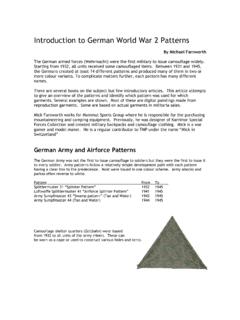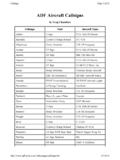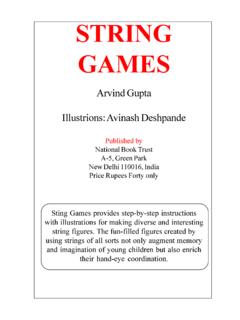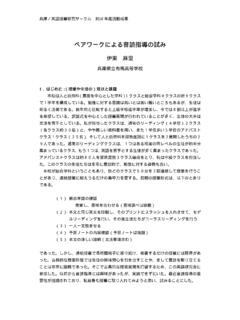Transcription of Hints and Tips - Artizan Designs
1 Hints & tips Painting Russian WW2 Copyright Mick Farnworth - March 2008 May 2010 1 Hints and tips Colour Guide Soviet Army By Michael Farnworth March 2008, Revised May 2010 Infantry Crusader figures painted by Mick Farnworth Artizan and Crusader figures are fully compatible and can be mixed in the same unit. Figures may be selected from both ranges can be used for the major campaigns. Item Colour Vallejo Model Colour Helmet Dark Green Russian Green Greatcoat Khaki US Field Drab , English Uniform , Flat Earth Uniform Khaki Green Russian Uniform Uniform (variant) Khaki US Field Drab , English Uniform , Flat Earth Uniform (variant) Tan US Tan Earth Uniform (faded) Beige German Camo Beige , Dark Sand Belt Brown Mahogany Brown , Flat Brown Blanket Grey Beige Sky Grey , Light Grey Webbing Beige German Camo Beige Pistol Holster Brown Mahogany Brown , Flat Brown Boots - Soldiers Black Black Hints & tips Painting Russian WW2 Copyright Mick Farnworth - March 2008 May 2010 2 Introduction This guide will help you to quickly paint units of soldiers to look good on a war games table.
2 Uniform notes, paint references and painting tips are included. Historical Notes The Russians call the period from 1941 to 1945 the Great Patriotic War. The German s invaded in June 1941 and advanced quickly, almost reaching Moscow. Almost 80% of the army was lost to the German s during Operation Barbarossa. Between 1941 and 1943, the Russians adopted desperate measures to hold back the Germans. The bloody battle of Stalingrad (Nov 1942- Jan 1943) stopped the advance. The battle of Kursk in July 1943 tipped the balance. From 1943 onwards, the Russian army took back ground lost to the Germans. Intro At the start of the war, the Soviet Red Army was nearly five million strong. It was mostly made up of Russian speakers from Russia, Belarus and Ukraine.
3 The officer class had suffered heavily in Stalin s purges of the late 1930 s. When the German s invaded in 1941, the army was large but had poor leadership. Nearly a million men were killed and three million captured. Of those captured, few survived to return to their homeland. After the huge losses of 1941 and 1942, the army was rebuilt. It included also ethnic minorities including Georgians, Cossacks, Uzbeks, Lithuanians and Armenians. In the later war years, almost 10% of the armed forces were women. Uniform Uniforms were basic and colours variable. There is a common misconception that Russian uniforms were yellow brown. The standard colour was an olive shade of khaki, similar to the colour used by Canadian and British forces. In practice the colours varied extensively from olive green through to pale brown.
4 Winter uniforms were made of woollen cloth and coloured in an olive green khaki. Padded winter jackets (telogreika) and trousers were widely used. Shade differences between jackets and trousers were common. Summer uniforms were made of cotton and faded to a cream colour. Greatcoats were in theory a dark brown colour, but various shades from brown through khaki to mid grey were used. The classic image of a Russian soldier shows the greatcoat rolled into a bedroll and carried diagonally over the shoulders. In the early war years, soldiers were equipped with black or brown ankle boots and khaki puttees. In later years, the standard boots were black jackboots. In winter, grey sealskin over-boots were issued to the lucky few. Helmets were mostly green but the colour varied from a dark olive to a lighter yellowy green.
5 Metal objects such as ammo boxes were usually olive green. Pouches and belts were often brown leather or khaki canvas. The main belt was fastened with an aluminium buckle. Hints & tips Painting Russian WW2 Copyright Mick Farnworth - March 2008 May 2010 3 Equipment The shortage of materials was a huge impediment. Many vehicles and heavy weapons had been lost during Barbarossa. The Americans and British provided huge amounts of equipment through the Lend Lease scheme. The Soviets took delivery of 7,000 tanks, 375,000 trucks, 50,000 Jeeps, 15 million pairs of boots and many more items. The Soviets concentrated on producing huge quantities of standardised items. The T34 tank was made in vast quantities. From late 1941, 35,000 of the 76 mm version were made and 22,000 of the improved 85mm were produced.
6 Mortars were used extensively as they were quicker to produce than artillery. The Maxim heavy machine gun with its characteristic wheeled trolley was extensively used as company support. Squad support was via the DP light machine gun. At the start of the war, most soldiers were equipped with Mosin Nagant rifles. By 1944, almost a third of the army was equipped with PPSh (or PP43) submachine guns as they were easier to produce than rifles and needed less training. In the early years of the war, PTRD and PTRS anti tank rifles were commonly used. After 1943, these were no longer effective against the increased armour on German tanks. Panzerfaust were captured in huge quantities from the retreating Germans and widely used by Soviet forces. Hints & tips Painting Russian WW2 Copyright Mick Farnworth - March 2008 May 2010 4 Painting tips Bases It is worth deciding on the rules that you are going to use before you start to base and paint the figures.
7 For WW2 skirmish games, most rules suggest individual bases. Some rules suggest 25mm diameter bases and some suggest 20mm diameter bases. Mass battle games often specify multiple bases to represent regiments. Plastic bases ( Slottabases), wooden bases, washers or coins are all suitable. 20mm steel washers can be used with magnetic bases so that the figures can be adapted to many different sets of rules. With heavy weapons, it is nice to make the base into a small diorama. Dependant on the size and shape of the weapon, you can use circular bases, rectangles or irregularly shaped bases. Large plastic and wooden base are available from many wargame suppliers. For circles, you can use such as mini CDs and CDs. With CDs, the flat side is the one with writing.
8 Build some ground onto the base using epoxy putty, and then cover with sand and grass. To make casualty removal during game play easy, this base has a removable figure. The loader is mounted on a 20mm steel washer. The base has a 19mm self adhesive magnet from Litko. When the Hints & tips Painting Russian WW2 Copyright Mick Farnworth - March 2008 May 2010 5 large base was made, the washer was held in place on the magnet whilst the putty was built up to the edge. Then the washer was wiggled and removed before the putty set, leaving a circular hole. Similarly, the gunner was wiggled and removed for painting. Painting Step by Step There are many ways to paint 28mm figures. Many people paint the clothing with a dark shade then the main colour and then a highlight colour.
9 For wargaming, where you want to get reasonably good results quickly, it is easier to paint only the main colours and then add shade with a wash of dark transparent stain. Here is a basic assembly and painting sequence for typical world war 2 soldiers. This method is designed for painting about 20 figures at a time. It is always a good idea to do a practice run on 5 figures first. The painting sequence is designed so that minor mistakes can be corrected at the highlight stage. There is no need to correct minor mistakes as you go along. 1. Remove mould risers, mismatch, and flash. Mould risers are typically found on hands, elbows, feet and weapons. Sometimes they can be flicked off with a fingernail but usually tweezers or needle nosed pliers are needed.
10 Occasionally they must be filed away with a needle file. TIP With Crusader French, check the area between the left arm and torso for flash. 2. Sand the base flat. Easiest way is to place a sheet of coarse sandpaper on a workbench. Hold the figure firmly and vertically in your right hand and push it over the sand paper. Two or three strokes should be enough to give a flat base. The base is flat when the underside is covered in scratches from the sandpaper. 3. Glue the figure to a base. If you are going to use individual bases, this will be the final base. Use cyanacrylate adhesive (superglue) for a permanent bond. If you are going to use multiple bases, use a coin as temporary base so that you can hold the figure for painting. For temporary bases, use PVA glue, as it is easy to remove later.







